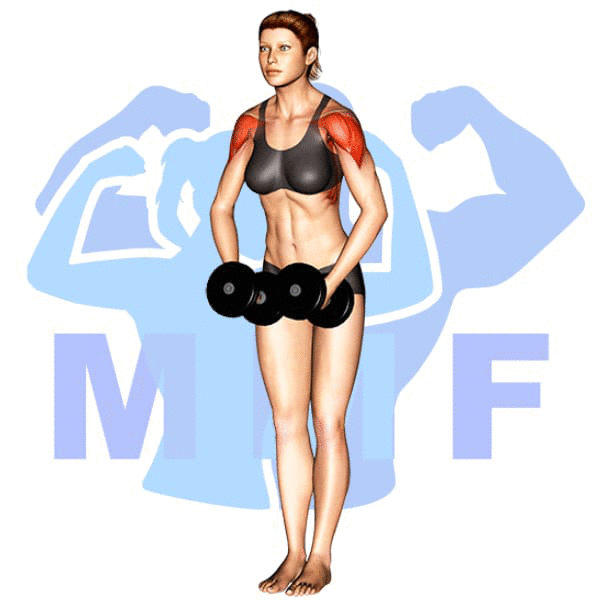As a personal trainer who works with a lot of women, I often hear about the struggles they have with the women’s dumbbell lateral raise. It’s a great exercise for toning the shoulders and upper arms, but many women find that they can’t seem to get the hang of it. Often, it’s because they’re not activating the right muscles or using too heavy of a weight. But don’t worry, there’s a solution! In this blog post, I’m going to break down the proper form and technique for the women’s dumbbell lateral raise, so you can perform the exercise with confidence and get the results you’re looking for.
Dumbbell Lateral Raise Summary
- Primary Muscles: Deltoid – Lateral
- Secondary Muscles: Deltoid – Anterior, Serratus Anterior, Supraspinatus, Trapezius – Lower, and Trapezius – Middle
- Equipment: Dumbbells and Bench
- Mechanics Type: Isolation
- Force: Push
- Utility: Auxiliary

Dumbbell Lateral Raise Instructions
- Stand up with feet hip width apart
- Hold a dumbbell in each hand
- Keep your arms straight and palms facing inward
- Raise your arms out to the side until they are parallel to the floor
- Slowly lower your arms back to the starting position
- Repeat for desired repetitions
Video Tutorial
Dumbbell Lateral Raise Muscles
Target (Agonist)
Synergists
Dynamic Stabilizers
- None
Stabilizers
- Levator Scapulae
- Trapezius – Upper
- Wrist Extensors
Antagonist Stabilizers
- None

Benefits of Dumbbell Lateral Raise
The Dumbbell Lateral Raise is a great exercise for targeting the lateral deltoid muscle, which is responsible for shoulder abduction. This exercise works the shoulder muscles by lifting the dumbbells out to the sides and engaging the muscles to hold the weight up. It is an effective way to increase shoulder strength, size, and definition. The lateral raise also helps to strengthen the stabilizing muscles around the shoulder joint, increasing overall stability and preventing injury. Additionally, this exercise can help improve posture by strengthening the upper back muscles and improving shoulder mobility.
Tips for Performing Dumbbell Lateral Raise
The dumbbell lateral raise is a great exercise to strengthen the shoulder muscles and improve your posture. If you’re looking to get fit and reap the benefits of this exercise, then you’ll need to do it correctly. Here are some tips on how to perform a dumbbell lateral raise for maximum results.
- Maintain Your Abs Tight. For most exercises and this is no exception, you should support your back bone by flexing your stomach to raise your interior pressure and support your spine.
- Watch Your Form by Make Use of a Mirror. You may think people are a little vain by staring into a mirror while exercising, but they are not just checking themselves out, they are insuring proper technique.
- Slow Every Repetition Down For Improved Strength Gains. By going slow you increase the time under tension and you are engaging your muscles longer, in response they will want to become stronger. You can do this without raising the resistance by doing the reps slowly, roughly 4 – 6 seconds constriction and pause then 4 – 6 seconds extension.
- Take Recovery Days. Even if you still want to exercise, instead of recovery you could mix up your program with a little cardio. Just understand, you need to permit your muscles time to recover, healing is how your muscles get stronger.
Benefits and Tips Video
Frequent Mistakes To Avoid
When it comes to the dumbbell lateral raise, it’s important to perform the move correctly in order to maximize your results and avoid injury. There are several mistakes that people often make when doing this exercise, and it’s important to be aware of them so that you can avoid them. Read on to discover the common mistakes and learn how to perform the exercise correctly.
- Doing the Exact Same Exercises Each And Every Time. Any time you get in a routine and do exactly the same lifts every workout session your muscles will build memory to execute those individual lifts well, and you will plateau very quickly.
- Lifting with Sloppy Technique. Incorrect form will certainly be a fast path to injury and a lack of improvement.
- Skipping Out On Recovery. Not allowing your muscle to fully recover is called over-training. To much Over-training will certainly make you weakened rather than stronger, since you tear your muscles down and don’t let them repair themselves.
Find More Dumbbell Exercises Here
Variations and Complementary Exercises
For those looking for a variety of exercises to work the same muscles as Dumbbell Lateral Raise, there are plenty of options to choose from. Below are some variations, complementary, and alternative exercises that can be used to target the same muscles as the Dumbbell Lateral Raise.
Reverse Grip Bent Over Dumbbell Row

The Reverse Grip Bent Over Dumbbell Row is an excellent alternative or complementary exercise to the Dumbbell Lateral Raise. It is an effective way to target the back muscles, and can be used to strengthen and tone the muscles of the upper back and shoulder. The movement involves holding a dumbbell in each hand with palms facing inward, slightly bent at the waist, and then pulling the weight up towards your chest in a rowing motion. This exercise helps to develop a stronger back, improved posture, and can also help to build muscle mass in the shoulders and upper back.
Bent Over Rotating Dumbbell Row

Bent Over Rotating Dumbbell Row is a great complementary or alternative exercise for Dumbbell Lateral Raise. It strengthens the muscles in the upper back and shoulders, which are important for providing stability and balance in daily activities. This exercise involves bending over with your back flat and chest out, then rotating your arms outwards to raise the dumbbells up to shoulder height. With this exercise, you’ll be able to increase the range of motion in your arms, as well as build strength and stability in your upper body. Bent Over Rotating Dumbbell Row is a great way to increase the intensity of your workout routine and provide a stronger foundation for other exercises.
Bent Over Dumbbell Row

The Bent Over Dumbbell Row is a great complementary or alternative exercise for the Dumbbell Lateral Raise. It helps to improve posture, strengthens the upper back, and engages the core muscles. To perform this exercise, stand with your feet shoulder width apart, holding a dumbbell in each hand. Keeping your back straight, bend at the waist until your torso is almost parallel to the floor. Pull the weights up towards your chest and squeeze your shoulder blades together before lowering the weights back down. This exercise can also be done with one arm at a time if needed.
Check Out These Top Dumbbell Exercises
Resistance Band Lateral Raises

Resistance Band Lateral Raises are a great complementary or alternative exercise to Dumbbell Lateral Raises. This exercise is an excellent way to work the shoulders and deltoids in a different way than what is done with dumbbells. With this exercise, the resistance band provides a consistent level of tension throughout the entire range of motion, which can help to improve muscle strength and endurance. Additionally, this exercise can be performed with minimal space, making it ideal for those who lack access to a gym or other equipment. Furthermore, the Resistance Band Lateral Raise can be used for both beginner and advanced exercisers, making it a great exercise for all fitness levels.
Resistance Band Upright Rows

Resistance Band Upright Rows are a great complementary or alternative exercise to Dumbbell Lateral Raises. This exercise works the muscles in the shoulders, upper back, and arms, similar to the Dumbbell Lateral Raise. The main difference is that Resistance Band Upright Rows use tension from a band or tube to create the resistance instead of using dumbbells. This makes it a great option for those who don’t have access to weights. It’s also a great exercise for those who want to increase their range of motion or target different areas of their muscles.
Dumbbell Lateral Raise

Dumbbell Lateral Raise is a great alternative or complementary exercise to Dumbbell Shoulder Press. This exercise targets the lateral deltoid muscles, which are responsible for shoulder abduction and help to create a strong, stable shoulder joint. It is also a great way to build shoulder strength and stability without putting too much strain on the shoulder joint. The exercise can be done with light to moderate weights and can be done with a slow and controlled motion to ensure proper form and reduce the risk of injury.
Find More Shoulders Exercises Here
Opposing Complementary Exercises
To further enhance your shoulder workout, you should also include exercises that work the opposing muscles. This will help create balance and stability in your shoulder muscles and provide an overall more effective workout. Below are some exercises that complement the Dumbbell Lateral Raise by using opposing muscle groups.
Resistance Band Flys

Resistance Band Flys are a great exercise to complement the Dumbbell Lateral Raise because it uses the opposing muscle group. This exercise is performed by standing with your feet shoulder width apart and holding the band in front of you, with your arms slightly bent. Then, you will spread the band out to the sides until your arms are fully extended. You will feel the muscles of your chest and shoulders working as you do this exercise. This movement is great for toning the muscles of your chest and shoulders while also providing a great stretching sensation. Resistance Band Flys can be used as a great way to warm up before doing any other chest or shoulder exercises, like the Dumbbell Lateral Raise.
Resistance Band Chest Press

The Resistance Band Chest Press is a great way to complement Dumbbell Lateral Raises in your workout routine. This exercise is designed to target the chest muscles while the Dumbbell Lateral Raise targets the shoulder muscles. By doing both exercises, you are engaging opposing muscle groups, allowing for a balanced workout. The Resistance Band Chest Press helps to build strength and stability in the chest while the Dumbbell Lateral Raise helps to build strength and stability in the shoulders. By doing both exercises, you can create a balanced and effective workout routine.
Resistance Band Push Ups

Resistance band push ups are a great complementary exercise to dumbbell lateral raises. Resistance band push ups target the opposing muscle group, working your chest, core, and triceps. They also help to build stability and strength throughout the body. This exercise is great for those looking to increase their overall strength and power. As the resistance band adds tension, it helps to challenge your muscles in a different way than a dumbbell lateral raise would. Additionally, resistance band push ups allow for a greater range of motion and can be done with various grips, which further increases the intensity of the exercise.
Elevate Your Upper Body Strength with Dumbbell Lateral Raise
One great way to enhance your upper body strength is by incorporating dumbbell lateral raises into your workout routine. This exercise targets the shoulders and can help you achieve a sculpted and toned look. Be sure to start with a weight that is comfortable for you and focus on proper form throughout each rep. Over time, you may gradually increase the weight for a more challenging workout. Remember to always listen to your body and take breaks if needed. With consistency and dedication, dumbbell lateral raises can help you reach your upper body fitness goals.
References: Wikipedia | ExRx.net | PubMed.gov | Comprehensive List of Shoulders Dumbbell Exercises


